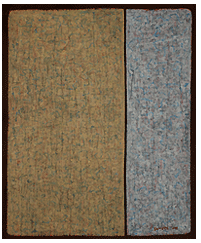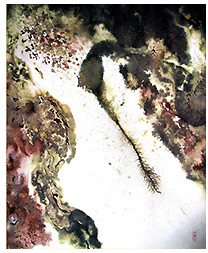- Prelude
- Guest Editor’s Column
- Hard Talk
- Digital Art
- The Write Stuff
- The Art of the Shakers : Shaker Furniture
- New Media
- In the News
- GenNext
- Report
- Artist Index and Statistics
- Market Insight
- Auction Reports
- The month that was
- Mumbai Artsighting
- Musings from Chennai
- Delhi Dias
- Deccan Odyssey
- Art Bengaluru
- In between – from Vadodara
- North-East Opsis
- A Tryst with Art in Madhya Pradesh
- Strands of Social Semiotics
- Transcending Popular
- Art of the Land & Land in Art (part I)
- Through The Patina
- Earth
- Go See India
- Dali's Elephant
- Malleable Memory
- Creative Impulse
- Different hues of Aakriti
- Bonhams : Fine Writing Instruments New York
ART news & views
Strands of Social Semiotics
Volume: 2 Issue No: 7 Month: 8 Year: 2010
An uninhibited freedom of subterfuge and play, the energy, dynamism, absorption and spontaneity reveal strands of social semiotic of what a culture talks about and the means and style of expression it employs to do so.  A tormenting thought that as of a certain point, history is no longer real and art practice, the accelerations of modernity has given 'us' the velocity enabling us to hurtle free of longer real and art practice the referential sphere of the real and the imaginary. Since the purpose of imagery is to remind us, by approximation, of those meanings for which the image stands, and since, apart from this, imagery is unnecessary for thought, we must be more familiar with the image than with which it clarifies. The paintings of four painters Sunil De, Sekhar Roy, Nobina Gupta, Pratibha Singh discussed here consist of a visual hold, an immediacy and enigmatic gripping presence.
A tormenting thought that as of a certain point, history is no longer real and art practice, the accelerations of modernity has given 'us' the velocity enabling us to hurtle free of longer real and art practice the referential sphere of the real and the imaginary. Since the purpose of imagery is to remind us, by approximation, of those meanings for which the image stands, and since, apart from this, imagery is unnecessary for thought, we must be more familiar with the image than with which it clarifies. The paintings of four painters Sunil De, Sekhar Roy, Nobina Gupta, Pratibha Singh discussed here consist of a visual hold, an immediacy and enigmatic gripping presence.
Sunil De's work in acrylic on canvas reveals the philosophical nature of his work and the consistency of his aesthetic beliefs. These ineffable qualities are the source of their distinction, their intimacy, inwardly generated and not imposed. Throughout his career Sunil was not concerned with the formal components, even today it has remained the same. In spite of his enormous erudition and sense of form and texture that remind of his earlier 'Wall' series, he puts them together with a calm detachment in which a clear structure combines intimately with solipsism and expressiveness to achieve a paradoxical visual image to create scenes of artifice that makes him one of those rare painters. But these artifices do not by any means resist our emotional identification or intellectual response. Celebrated by his contemporaries for his formal rigour and invention, his language provides unending possibilities for learned exegesis and decoding his gestural rhetoric. We see the large modulations and brilliant duchromatic fields obtained through difference of values spread before us, which does not consist not only of relations of warm and cool, of expansion and contraction, which vary in accordance with the colours considered. It also consists of regimes of restrained palette, the relations between these regimes, and the harmonies between tones. He is steadfast in his quest to invent the most effective means to communicate it to us. He reminds us that the progression of a painter's work is toward clarity, toward the elimination of all obstacles between the painter and the idea, and between the idea and the observer. He gives as examples of these obstacles: memory, history and geometry.  These works suggest a passage of time for Sunil, an extremely precocious painter in his early years, both in time, his own evolution and the body he produces. The dynamism in the present series is a subtle indication of changed circumstances.
These works suggest a passage of time for Sunil, an extremely precocious painter in his early years, both in time, his own evolution and the body he produces. The dynamism in the present series is a subtle indication of changed circumstances.
In Nobina Gupta's water colours there is a turning away from specific description towards an allusive mix of abstraction and the sensuous physicality of colour regimes. Her involvement in light illusory space, dreamy moods create the illusion of looking through a kind of underwater that is illuminated from beyond by diffused sunlight. If Nobina celebrates weightlessness of the Far East tradition of water colours articulated in terms of a picture-script, she voices gravity in somber paintings suffused with a submarine glow. Here oceanic blue submerges every other colour in certain paintings like 'Crystallized Fantasia' or 'Alluring Fervour', bands of russet crimson and dusty brown fall in broken ridges, at the bottom of the avalanche, a pinpoint blast of red reminds that is the hour of sunrise after the rains. In the far distance, things dissolve into a dusky haze tinted with yellow, orange and grey. There is a degree of impressionistic naturalism about this especially in the depiction of light, but what is more strongly projected is an otherwordly numinous quality. There's a literalism about the 'wash down stream' imagery that makes the makes the paintings evocative combined with an imaginal vision, formal complexity and luxurious painterly sensuality that makes them work so well. It is fitting that Nobina's language is implicit in its evolutionary path often evokes and on several occasions actually realize the potentials of a meditative enclosure and  are replete with images of a static eternity that substitutes the external one translating feeling and emotions into a visual language- the implacable absolute of otherness.
are replete with images of a static eternity that substitutes the external one translating feeling and emotions into a visual language- the implacable absolute of otherness.
Sekhar Roy resuscitates sublimating drives to abandon the old and rediscover domestic/indigenous spaces like his present acrylics on canvas where the self' acts as a surface of projection of power mechanisms. In the present series, there are attempts to compose, to invent. He stresses the deliberateness of his process and enumerated the ingredients that constitute his painting and measures them carefully. He considers his jagged figures to be actual objects that he positions on a stained field. His paintings are not arrangements of those flat architectural markers that divide the picture plane, nor are they vast atmospheric backdrops but sublime texts where he uses light and keeps the source as a revelation of some kind of inward and natural trepidations of the soul. The works embody a strong sense of theatre. For the most part scenes are depicted from a low vantage point, so that the figures loom over the viewer, mythic in stature. On occasion, the viewer cannot help feeling that the proscenium has broken down, not to let the viewer enter, but to permit an entry from the wings. The diagram that joins the matrices is never an optical effect, which appears as chance, accident or the involvement of figures that are isolated despite the subtlety of their combinations. The important fact is that they do not consign the figure to immobility but on the contrary, render sensible a kind of progression, These are made under the threat of potential loss, and this does not always resolve itself in the artist's favour permeated by an undeniable sense of sadness, and awareness of the anguish, frailty and impermanence of life. He makes pictorial and aesthetic sense out of a personal despair and its experience of a torn and injured world. His ability to conjure up experience through the shape and weight of lines and rhythms of composition are eloquent. The works have a nervous, inchoate narrative quality, as figures, vulnerable like an upturned inscription; but also, resolute like an image that refuses the journey across the mind's aperture in a stop-go movement- a realist balance that has long ceased to be a picture-fable. The images here refuse to disavow their own separation in a narrative splurge that reminds us that the “purity of narrative is more manifest than that of discourse” (-Gerard Genette). They create their own untimely rhythm which he records, in what we feel to be a coolly objective way. In the end it makes us seek his work out as if we needed it, and makes us cherish it, long after more documentary or photographic evidence of “our common suffering” has become a sad blur. Something of the same quality is transmitted- an oddness, a disturbing quiet. Whether this desperate humanism, sustained only by the sheer energy of despair, does not fail to recognize at least one major resource which exists,  almost visibly, in the very fact of our language. Being would emerge at last through the image.
almost visibly, in the very fact of our language. Being would emerge at last through the image.
In Pratibha Singh's series titled ‘Earth’ done in acrylic on canvas introduces a tantalizingly cerebral artist whose ideas hover just on the brink of obscurity. She traces humankind's progress towards private property and avarice into a vast and gloomy subterranean asphalt jungle. It's as if the enigmatic mind of Jorge Louis Borges had been fused with the majestic spirit of Diderot. There is something compelling about these works. Singh is a latter- day conceptualist whose work is animated by something vaguely prophetic- schematic diagrams drawn in which she pins in irregular multiple grids. The painted spaces are zany and visionary as if the artist was suddenly possessed with ideas and just had to get them drawn. Singh massed an enormous amount of content on a tiny act as she tries to encompass the phenomenological implications of her concerns and beliefs. The diagrams are complex and somewhat may look impenetrable that may collapse in its own weight. She loves tangents, incompletion and reversal that intrigue. She invents thoughts, turns it inside out, takes unexpected turns and juxtaposes different ideas in order to create new perceptions of the world. She layers information the way other artists layer materials. She takes us on an amazing journey that is lucid if not brilliant keeping in mind that the key to any successful conceptually based art is to be able to ingrain thought in material. Otherwise everything's just a dream.
Their poise is remarkable, what these four painters accomplish is a discreet, satisfying mélange, each of whom is confident and possesses a sprightly distinctive approach. The accounts and language that the participants offer, make for a lively diversity of angles and satisfying narrative styles
- Nanak Ganguly